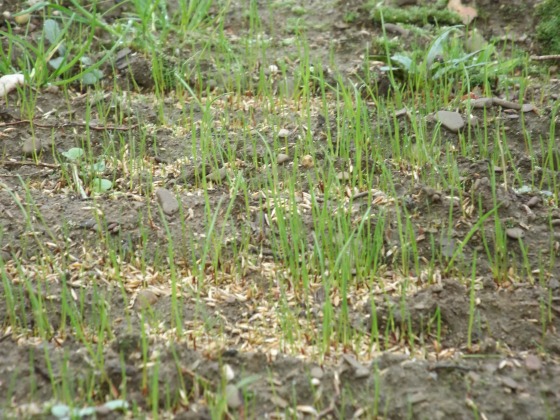
Time seems to freeze when you’re waiting for a lawn to grow. Most people expect fairly quick results, but the truth is different types of grass germinate at much different rates. Some can be expected to sprout within a week. Others can take almost a month. How do we know when to wait it out and when to begin reseeding?
Type of Grass Expected Germination Time
Bentgrass 10-14 Days
Bermuda Grass 10-30 Days
Buffalo Grass 14-30 Days
Centipede Grass 14-21 Days
Fescue 7-14 Days
Kentucky Bluegrass 14-30 Days
Rough Bluegrass 7-10 Days
Ryegrass 5-10 Days
Keep in mind that not all your seeds will sprout at the same time. If you’ve waited the expected time and your seeded area is still showing no signs of life, improper moisture level or soil temperature is probably the culprit.
The two most important factors in grass germination are water and soil temperatures. If there is too little moisture your seeds will dry out and a dry seed is a dead seed. Don’t try to add water now, it’s too late. Too much moisture and your seeds will rot. Over saturated soil prevents sprouts from getting the oxygen they need for survival.
Water the grass seed just enough to keep the top 2 inches of soil moist. Giving the area a good watering a day or two prior to spreading seed can help avoid dry spots. The soil should be moist, but not spongy. If you notice water puddling on the surface, you are over-watering. A small amount of water given often is the safest bet.
Soil Temperatures
To understand the proper soil temperature, first you need to know that there are cool season grasses and warm season grasses. These names have nothing to do with the season of growth (they both grow spring through fall). Instead, the name implies the area where the grass thrives. Warm season grass thrives best in the warmer areas of the U.S or the Southern and Southwestern states. Cool season grass grows best in the Northern, Midwest and Pacific Northwest regions of the U.S. There is a transition zone where both grasses can be used (often at the same time to ensure that grass is growing throughout the summer).
Cool Season Grass
Cool season grasses include Bentgrass, Bluegrass, Fescue, and Ryegrass. Cool season grasses begin growing in the spring and are happiest when temperatures are between 60-75 degrees (F). They are usually quick to germinate and quick to begin growing.
Warm Season Grass
Warm season grasses like Bermuda, Centipede, Zoysia, Buffalo, and Bahia grass, tend to be a little slower to germinate. Warm season grasses are happiest when the thermometer is reading 80-95 degrees (F). Once the air temperatures begin to drop below 65 degrees, the grass goes dormant and turns brown. Some homeowners overseed their warm season grass with cool season grass. This keeps their grass green throughout most of the year.
Overseeding
Overseeding is spreading seed over existing grass. This can be done to create a more lush lawn and fill in thin spots (before the weeds fill them in!) or as stated above, to grow both cool and warm season grass together. You can easily do this by mowing your grass short, spreading some seed and watering.
Germination
Most germination failure, especially with warm season grass, is because the grass seed was planted too early. Grass seeds have an outer shell (the hull) that prevents germination until conditions are right. Proper soil temperature is a big factor in the success you’ll have. For cool season grass, the ideal soil temperature is a minimum of 45-55 degrees (F). For warm season grass, the ideal soil temperature is a minimum of 55-65 degrees (F). Most of us don’t have a soil thermometer…and soil temperature is usually cooler than the air temperature…so I’m going to stick my neck out and say:
The perfect air temperature for spreading cool season grass seed is 60-70 degrees (F). The perfect air temperature for spreading warm season grass seed is right around 80-85 degrees (F).
A Helpful Tip
When choosing your grass seed look for the germination rate on the label. This is the percentage of seeds that germinated in lab tests and the higher the score, the better. A rating of 90-95% is ideal. Each year that you store your bag of seed will result in a 10-25% decrease in your germination rate. If you have a bag of seed that has been sitting for a few years, scoop out a handful and gently blow across the top. If they fly away, they are just dead chaff.
Pre-Germination
Pre-germinate your seeds to get a lush lawn, faster. Begin by placing your seeds in a burlap bag. Now place that bag in a tub filled with room temperature water and hold the bag down until it soaks up the water and stays submerged. Store your tub somewhere where the temperature is 65-75 degrees (F). Put a lid on the tub, cover it, or keep it in a dark room.
Each day, remove the sack and let it drain a little while you refill the tub with fresh room temperature water. Around the 7th day, begin checking for shoots emerging from the seeds. When you see shoots, take the burlap bag out of the tub and let it drain until it stops dripping. Dump out the water from the tub and cover the bottom of the tub with a layer of sand or compost.
Sprinkle the seed on top of the sand (or compost) and let it dry for 30- 60 minutes. Mix the seeds in with the sand/or compost, which makes it easier to spread. Spread it over the prepared area and rake it out to distribute it evenly. Water a little, as often as needed, and you will have a lawn in a few days.
Side Note
I frequently get asked which grass to grow in hot areas. For hot-dry areas Bermuda grass is the most drought tolerant. For hot-humid areas, Zoysia, St Augustine, Centipede and Bahiagrass do well. If you have an established lawn and are dealing with drought or you just want to save money on your water bill, read this article on how applying a rooting hormone to your yard can help your grass.
Mike McGroarty is the owner of McGroarty Enterprises and the author of several books. You can visit his website at FreePlants.com and read his blog at MikeBackYardNursery.com.
Related Articles
Early Growth Fertilizer Regiments for Propagation & Vegetative Stages
Growing Healthy, Productive and Profitable Plants through Succession Planting




Comment here